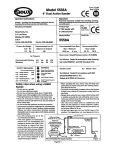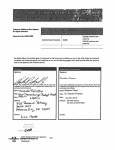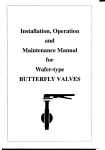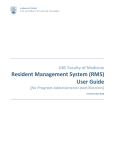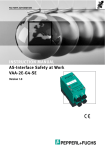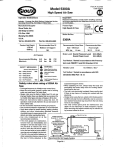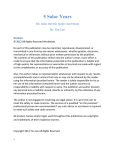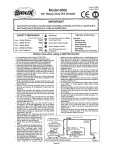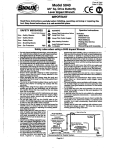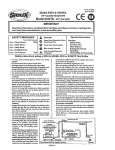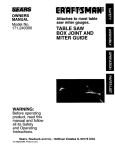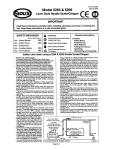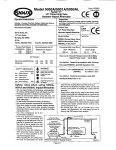Download Sioux Tools 5550 User's Manual
Transcript
- Form # Z470 Date 1- W A Model 5550 C? @ 1/2" Sq. Drive Pistol Grip . Impact Tool IMPORTANT 1 Read these instructions carefully before installing, operating, servicing or repairingthis tool. Keep these instructions in a safe accessible place. I SAFETY MESSAGES 1 1A Always Read Instructions Using PowerTwls PeoonalSafetyEqucment Use - Safety Glasses Use Safety Gloves Use Safety Boots Use - Breathing Masks Use Ear Protectors - - - YES 1 WARNING @ Always Wear Safety Goggles @ Wear Hearingprotection A Avoid Prolonged Exposure To Vibration 1 II Operator Instructions includes: Safety R u k Foreseen Use Work Stations Putting Into Service Operating Dismantling and Assembly. Safety rules when using a 5550 ImpactTool - Use only impactsockets and extensions,universaljointe, etc., rated as being suitable for use with impact tools. - Prcibqed exposure to vibration may cause injury. .- ReadaBjnstrucfionsbeforetKhgltfetoot.AIoperatorsmust beMytrainedinitsuseandawareoftiesesafetyrules. - Do not exceed the maximum working air pressure. - Use personal protectionequipment & recommerKled- WcofnpressedsironlyattÈrecornnerxledconcflions practicaltoremovetoolfromsewh, thanshutofftheair supply to the too! and write or have written a warning note and attach it to the tod. - I f tool is to be used wtt) a baiancer or other suspension device,ensure that the too)is firmly attached to the suspension/supportdevice. - When operating the tori, always keep the body and the handsaway from the woriang attachment Theiwlisnoteiectri insulated.Neveruseftatoolif there is any chance o into contact w ' h li electricity. - Always when using the too[,adopt a firm footing and/or posHion and p the tool sufficiently arty to overcome any reaction ces that may result from the tool doing work. Do not ororgrip. - Use only correct spare parts for maintenanceand repair. Do not improvise or make temporary repairs- Major servicing and repairs should only be carried out by cany e - personstrainedtodoso. Do not lock,tape, wire, etc. the 'On/Off valve in "On' position.'me tfvotfte trigger/tever, etc. must ahvays be free to return to lhe "Off"positron when released. other person or material or substance that could be contaminatedby oil droplets.When first lubricating a tool or if the tool exhaust has a high oil content, do not allow the exhaust air to come near very hot surfaces or flames. Never lay the too! down until the working attachment has stopped-moving- When the tool is not in use, shut off the air supply and press Ihrotfle frioaerfiever to drain the supply line. I f the tool is not to be used for a periodof time, first lubricate, dsconnectfroman-supplyandstoreinadryaverageroom temperature environment - If the fool is passed from one user to a new or inexperienced user. make sure these instructionsare available to be passed withthetool. - Do not remove any manufacturer fitted safety devices where fitted, i.e., wheel guards, safety trigger. speed go-, etcWherever p-e, secure workpiece with clamps, a vise, etc.tomate itngtd soçtdoesnomoveduringthe work operation.Keep good balance at aU times. Do not stretch or overreach. - Try to match the tool to (he work operation. Do not use a tod that is too light or heavy for the work operation. If in doubt, seek advice. in generalterms, this tool is not suitabie for underwater use or use inexplosive envirmrnente-seek advice from manufacturer. - - immed"lately If the tool appears to malfunction, remove from use and arrange for service and -r. ti it is not KExw. requirements when instaihng, usingor maintainingthe tool. - Take care W#eexhaust air does not point towante any shutofftheairsupplytoVnetootandpressthe Obefore n / Wfitting, valve to exhaust the air from the feed hose removing or adjusting the working attachmentfittedtothetool. - shutoffdeucehasbeenfittedtothe Beforeusinothatool.makesurethata . - - Tvtomakesurethattheworkareaisdeartoenablethe work task to be performed safely. If practical and - possible, b'y to ctear unnecessary obstructions before starting work. Always use air hose and couplings with minimum working pressure ratings at least 1 1/2 times the maximum working pressure rating of the tooL supply tine and the position is known andeasilyaccessiblesothattheair supply to thetoolcanbeshutoff inan emergency. - CheckhoseandfitSngsreoulartyfcfwear. - Takecareagainstentanglementofthe movtrgpartedttwtoolwithdoÈwg,hair To Maintain FteconnnenitKt fes,deaningrags.rings,jewafry.watrfres. bracelets,ete.'nrecotAJcauseftebody orpartsoftktbodytobedrawnfcwaids axiricortactwflhihemovingpartsofSw toolandcouldbevarydangerous. - itisexpectedthatuserswiladoptsafe working practices and observe all local, regional or country legal Recommended Air Supply System Pager401 Figure 1 Foreseen Use Of The Tool - 5550 The Impact tool is designed for the tightening and loosening of threaded fastener within the range as specified by the manufacturer. It should only be used inconjunction with suitable impact type 112" square female drive nut running sockets. Only use sockets which are of Die Impact type. It is allowed to use suitable extensionbars, universal joints and socket adaptors betweenthe square output drive of the impact tool and the female square drive of the socket. Do not use the tool for any other purpose than that specified without consulting the manufacturer or the manufacturer's authorized supplier. To do so may be dangerous. Never use an impact tool as a hammerto dislodge or straightencross threaded fasteners. Never attempt to modifythe tool for other uses and never modify the tool for even its recommended use as a nutrunner. Work Stations The tool should only be usedasa handheld, handoperated toot.# Isalways ~~~OInmended that the tool is usedwhen standingon a solid floor. It can be used in other positions, but before any such use, the operator must be in a secure position having a firm grip and footing and be aware that when loosening fasteners the tool can move quite quickly away from the fastener being undone. An allowance must always be made for this rearward movement so as to avoid the possibilityof handlarmhmdyentrapment. Putting Into Service Air Supply Use a clean lubricatedair supply that will give a measuredair pressure at the tool of 90 PSIQ (6.2 bar) when the tool is runningwith the triggerhever fully depressed. Use recommendedhose size and length. Itis recommendedthat the tool is connected to the air suoolv as shown In figure 1. Do not connect the tool to the air line system without incorporatingan easy to reach andoperate air shut off vake.The air supply should be lubricated. It Is strongly recommendedthat an air filter, regulator, lubricator (FRL) is used as shown in Fgiure 1 as thls will supply dean, lubricated air at the correct pressure to the tool. Details of such equipment can beobtainedfrom your supplier. If such equipmentis not used, then the tool shouldbe lubricatedby shutting offthe air supply to the tool, depressurizingthe line by pressing the trigger on the tool. Disconnect the air line and pour into the hose adaptor a teaspoonful (5ml) of a suitable pneumatic motor lubricatingoil preferably incorporating a rust inhibitor. Reconnect tool to air supply and run tool slowly for a few seconds to allow air to circulate the oil. tf tool Is used frequently, lubricateon daily basis and If tool starts to slow or lose power. It is recommended that joint tightness of the threaded fastener assembly be checked with a toque wench. It is recommendedthat the air pressure at the tool while the tool is running is 90 PSI/6.2 bar. Operating The output of the impact tool in prime working condition is governedby mainly three factors: a) the Input air pressure; b) the time the impact tool is operated on the joint. Normaltime for joints of average tension requirement3 to 5 seconds; c) the setting of the air regulator for a given joint at a given pressure operated for a given time. The air regulator (14) can be used to regulate the output of the impact tool if no other means of control is available. It is strongly recommendedthat an external pressure regulator. Ideallyas part of a filterlregulator~lubricator (FRL), is usedto control air inlet pressure so that the pressure can be set to help control the tension requiredto be applied to the threaded fastener joint. There is no consistent, reliable toque adjustment on an Impact tool of thls type. However, the air regulator can be used to adjust toque to the approximatetightness of a known threaded joint To set the tool to the desired toque, select a nut or screw of known tightness of the same size, thread pitch and thread condition as those on the job. Turn air regulator to low position, apply tool to nut and gradually increase power (turn regulator to admit more aio until nut moves slightly In the direction it was originally set. The tool is now set to duplicate that tightness, note regulator setting for future use. When tightening nuts not requiring critical toque values, run nut up flush and then tighten an additional onequarter to one-half tum (slight additionalturning is necessary if gaskets are being clamped). For additional power needed on disassemblywork, turn regulatorto its fully open posWton. This impact tool is rated a 1/2" bolt size. Ratingmust be downgradedfor springU bolts, tie bolts, long cap screws, doubledepth nuts, badlyrustedconditions and spring fasteners as they absoib much of the impact power. When possible, clamp or wedge the bolt to prevent springback. Soak rusted nuts in penetratingoil and break rust seal before removing with impact tool. If nut does not start to move in three to five Seconds use a larger size Impacttool. Do not use Impact tool beyond rated capacity as this will drastically reduce tool life. NOTE: Actual toque on a fastener Is directly relatedto joint hardness, too) speed, conditionof socket and the time the tool is allowed to impact. Use the simplestpossible tool-to-socket hook up. Every connectionabsorbs energy and reduces power. The direction of rotationof this tool is controlled by the throttle lever. Be sure that it is known which side of the lever has to be pressed to give the required directionof rotation before applying the impacttool to the joint to be fastened or loosened. For best results: 1) Always use the correct size impact type socket. 2) Use extra deep sockets in place of extension bars where possible. 3) Do not use oversized, worn or cracked sockets. 4) Hold the tool so the socket fits squarely on the fastener. Hold the tool firmly, but not too tightly, pressing slightly forward. Dismantling & Assembly Instructions DiSC~nnecttool from air supply. Remove protectiveboot (46). Remove oil plug (22) and drain oil into a suitable container. Grip motor housing (1) in a vise fitted with soft jaws and remove hose adaptor (10) together with spring (9), O-ring retainer (8), valve stem (6) fitted with O-ring (7). Drive out spring pin (15) and carefully pull out regulator (14) together with O-ring (13). O-ring (13) may be pried off of regulator (14) but do not attempt to remove the small ball. Driveout spring pin (12) and remove trigger (11). Inserta small diameter rod into the hose adaptor hole and push out throttle pushpin (4) together with O-ring (5) via the trigger pin slot. Unscrew retainerplug (21) and remove spring (20) and reverse valve stop pin (19). Reversevalve (18) may now be pushedout of motor housing (1). Do not attempt to remove the brass reverse valve bushing from the motor housing (1). Remove2 screws (17) and exhaust deflector (16). Remove4 cap screws with washers (45) and removeend cap (44) and gasket (43). By gently tapping the square end of anvil (29) the complete hammer assembly and motor assembly may be removedfrom the rear end of motor housing (1). Oil seal (2) may be hooked out of, and anvil bushing (3) pressed out of motor housing (1). Pull apart the motor and hammer assemblies. Remove guide pin (38) and pull off rear end plate (34) and front end plate (42) from rotor (35) and remove 6 rotor blades (36) and cylinder (37) notingits orientationwith the front end platefor correct reassembly. Bearing (33) may be tapped out of rear end plate (32) and bearing (40) from front end plate (42) with a suitable punch and oil seal (39) hooked out of front end plate (42). Remove O-ring (41) from end plate442). Removeanvil spacer (30) and pull out anvil (29) to separate hammer cage (a), cam ball pilot (24). ball (251, hammer cam (26). s p m (28) and 2 pins (27). Note that on reassembly, the chamfer on the bore of anvil spacer faces towards hammer cage (23). Socket retaining ring (32) and O-ring (31) may be removedfrom anvil (29). Page No 2 5550 112" Square Drive Pistol Grip Impact Tool ~ e fNO. . 26 27 28 29 30 31 Page 1 Pan NO. 505177 505178 505179 505380 505181 66673 Description Hammer Cam Hammer Pin (2)' Cam Release Spring Std. Anvil Assy. (includes items 31 & 32) Anvil Spacer 0-Rim Reassembly Ctona>conxunenipartsamiexanftÈfc)rwearand<Èac^etc,Èxf~as[~cessa~yLeÈklnpaificularkrvf~r 0-rt^andseakwearmrotorUadesarriwearandctactaonanvtt(29)parBc^riyhhan^ofttiswtiafedrtw-l^^~(~), cam(W),cambaflp^<24)arelhamnerpins(27).Makesurethatthefecesof mdplates(34)d (42)9^alxfttt^~i11IUerWare Batandfreeofbuns.LaponaMfimgiç^(tfatwasivepaper#necessary.Useone(nanubcurerorauHwnz^ti~m~e~m Ugt^~talpartsw^asuitatepneumatetoolhibrtcatingoila^reassembtein~rev>af~Older. Oncompletingtheassemfify,matesuretheanvilisfreetorotateandIhe(everandregulatoroperatefreaty.Removeoilplug(22)and p~hone<x~ue(28cc)dastxtal^??10orSAE^gif^oLDoiKftoveiffllasttiteWresiftinared^d~~rdhW. Pi>urapprox.5trtoiagood(iu~poewaBctoolnKitorht>ricatioaoB(pf^~ma~amt~w~&Mm thetriggerdepressetLCornedb~l~asuilabteair~a>KJopec^etodskn^forafewse^^&~hd~ti&ted& for operation requtred. Refer to section^QpeiaBng". operationspecification 3.5 dm (25 sc(m) Air Consumption 4eo It lb. (624Nm) -Ttxque W0tking-W Air MetThread ft. Q 6 (1 1/4'18MPT 50- 1 -nLength 7.5" (190mm) at90P8H3(62bd ProductType 112" Sq. Drive Pistol Grip ImpactTool Manufacturer/SuppT1~r SiouxTools Inc. 2901 Floyd Boulevard P.O. Box 507 Sioux City,IA 51102 Serial No. U.S.A. Tel No. 712-252-0525 Product Netweight 5.3 Ibs Kg 1I 1 RecommendedHose Bore 1 1 Size - Minimum 1 5/16 Ins 8 W M I 1 Fax No. 712-252-4267 1 1 1 I Recornmendod UseOl ~aiancerOrSupport NO SAFETYMESSAGES Use-SafetyUse-SafetyGlows Use-SafetyUse - B r e a m Masks Usa -Ear Protectors YES 10 M Sound Power Level 102.0 dB(A) bar 90 PSI bar 90 PSI A @ Test Method: Tested in accordance with Pneurop 1 test code PN8NTCI and IS0 Standard 3744 WARNING assar- Vibration Level Less than 2.7 Meters1Set2 Ww Safety Gooctes -- Test Method: Tested in accordancewith ISO AtiÈay = Hose Length 30 Ft Noise Level: Sound Pressure Level 91-0 dB(A) Air Pressure RecornrnendedWorking 6.2 Maximum 6.2 Recommended Max. A) WMrHatnig- A A u w PrcilonsedExposure standards8662Parts1&7 Bwx&b-i - Declaration of Conformity SiouxToots Inc. 2901 Floyd Boulevard, P.O. Box 507, Sioux City, Iowa 51102 declareunderoursoleresponsibBityVattheproduct M o d e l 5550 Sq. Dr. Pistol Grip ImpactTool, Serial Number towhichÈusdeclarationrotatesiskiconfonrttvwiththefctowingstctf)da@s)orottÈer-- EN792 (Draft), EN292 Parts 1 & 2, ISO 8662 Parts 1 & 7, Pneurop PN8MTC1 89/39 as dB)byglfiffiaEECS44/EI,EC Directives fallowingttwprovisionsof -------------< bertson (V.PfG.M.) ------+-------- N-aidsignBtureoreçÈaten(niaikhgdauthorizedpais Page No 4 a




